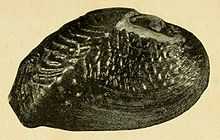Quincuncina
| Quincuncina | |
|---|---|
 | |
| External shell structure of Quincuncina burkei from the original description of the species. | |
| Scientific classification | |
| Kingdom: | Animalia |
| Phylum: | Mollusca |
| Class: | Bivalvia |
| Order: | Unionoida |
| Family: | Unionidae |
| Genus: | Quincuncina Ortmann, 1922[1] |
Quincuncina is a genus of freshwater mussels, aquatic bivalve mollusks in the family Unionidae, the river mussels.
Species
Species in the genus Quincuncina include:
- Quincuncina burkei Walker, 1922
- Quincuncina infucata (Conrad, 1834)
- Quincuncina mitchelli (Simpson, 1895) - false spike
Original description
Genus Quincuncina was originally described by Arnold Edward Ortmann in 1922.[1]
Ortmann's original text (the original description) reads as follows:
| “ |
Quincuncina Ortmann. The genus Quincuncina is founded upon the new species Quincuncina burkei Walker. I have received from the late H. H. Smith from the Choctahatchee River, Blue Springs, Barbour County Ala., several shells and the soft parts of seven other, five males, one barren and one gravid female, the latter collected May 12, 1915. Supraanal opening present, separated from the anal by a short mantle-connection. Anal opening about as long as the supraanal, its inner edge finely crenulated. Branchial opening about as large as the anal with distinct papillae. Palpi subfalciform, their posterior margins connected for about one-half of their length. Gills of normal Unione shape and structure. Inner lamina of inner gill free from abdominal sac except at its anterior end. Since the gill is rather short, the connected portion is about one- third the length of the abdominal sac. Gill diaphragm of the usual type. Septa of the gills, in the male, moderately developed, not very closely set; in the female, all four gills serve as marsupium, and the septa are strongly developed and stand close together. When gravid, the gills do not swell much and the ovisacs (water-tubes) are filled with sub cylindrical placentae. The gravid female at hand had only embryos in an early stage, but no glochidia. The color of the placentae could not be ascertained in consequence of the preservation in alcohol, in which they appear grayish-white. The most characteristic anatomical feature of the present species is found in the marsupium, which is formed by the four gills, and has sub cylindrical placentae. In these particulars it resembles only one genus, Fusconaia, and also the rest of the anatomy does not differ from that of this genus. However, in shell characters, this species is distinct from all known species of Fusconaia. In the latter we never see any sculpture on the disk and the beak sculpture is quite poorly developed, simple and concentric. In Quincuncina we have a rather complex zig-zag sculpture on the shell, following the subconcentric beak-sculpture. Certain species of Quadrula have indications of the sculpture (Q. cylindrica, for instance); but these species differ from the present one by the lanceolate and compressed placentae. However, there are two species which have been placed in Quadrula, U. infucatus Conrad and U. kleinianus Lea, which have a sculpture much like that of Quincuncina burkei. Of U. kleinianus, Lea (Journ. Acad. Phila., 1863, p, 404, and Obs. 10, 1863) has described the soft parts and, so far as the description goes, it agrees very well with the present species, except that the inner lamina of the inner gill is said to be free only half the length of the abdominal sac and that the anal opening is described as smooth; these are very insignificant differences, indeed. The most important character mentioned by Lea is that all four gills of kleinianus are marsupial. H. H. Smith has sent me the soft parts of two males of infucatus. Also here the anatomy is the same so far as can be observed. The inner lamina of the inner gill agrees with Q. burkei, while the anal opening is smooth as in U. kleinianus. It is more than probable that U. infacatus and kleinianus also belong to our new genus Quinciincina, the type of which is Q. burkei. It is a very primitive form of the subfamily Unioninae and stands, in its anatomy, close to Fusconaia, from which it differs, however, by the very peculiar sculpture of the shell, which, indeed, is rather unique among North American Naiades. The generic diagnosis of Quincuncina would be as follows: Soft parts of the type of the family Unionidae subfamily Unioninae much like those of the genus Fusconaia. All four gills marsupial, when charged not much swelled, and with subcylindrical (not lanceolate and compressed) placentae. Shell sculptured. The beak sculpture subconcentric, and followed upon the disk by bars of zig-zag type extending to a considerable distance and being much broken up so as to offer, at least upon parts of the disk, a quincuncial arrangement of nodules. |
” |
References
- ↑ 1.0 1.1 Ortmann A. E. & Walker B.. July 1922. The Nautilus, Volume 35, number 1, pages 1-6.